A New Method for the Correction of Spectrum Drift Caused by Temperature Changes When Using a NaI(Tl) Seawater Radioactivity Sensor
Abstract
1. Introduction
2. Experiment Devices and Methods
2.1. Experiment Devices
2.1.1. Seawater Radioactivity Sensor
2.1.2. Temperature Experiment Boxes
2.2. Experiment Methods
2.2.1. Experiment on the Relationship Law between Temperature and Peak Position Channel Address
2.2.2. Experiment on the Relationship Law between Gain and Peak Position Channel Address
3. Experiment Results and Analysis
3.1. Relationship Law between Temperature and Peak Position Channel Address
3.2. Relationship Law between Gain and Peak Position Channel Address
4. Correction Algorithm and Process
4.1. Correction Algorithm
4.1.1. Gain Adjustment Part Correction Algorithm
4.1.2. Spectrum Processing Part Correction Algorithm
4.2. Correction Process
- (1)
- The cumulative measurement time of the seawater radioactivity sensor exceeds seven days.
- (2)
- The seawater radioactivity sensor performs the restart operation.
- (3)
- The seawater radioactivity sensor undergoes considerable changes in the measurement position during use, including displacement changes in the horizontal distance and vertical depth.
- (4)
- Extreme weather conditions such as strong winds, high waves, and heavy rainfall occur in the deployment sea area of the seawater radioactivity sensor.
5. Results and Discussion of Correction Method Verification
5.1. Laboratory Verification
5.1.1. Air Environment Correction Method Verification
5.1.2. Water Environment Correction Method Verification
5.2. Seawater Onsite Verification
5.2.1. Drift Correction under Normal Weather Conditions
5.2.2. Drift Correction under Precipitation Weather Conditions
6. Conclusions
- (1)
- When the environment temperature of the seawater radioactivity sensor changes, the peak position channel address is the quadratic function of the temperature, and the inflection point of the peak position channel address change is 15 °C. When the temperature is lower than 15 °C, the peak position channel address increases with the increase of temperature. When the temperature is higher than 15 °C, the peak position channel address decreases with the increase of temperature.
- (2)
- The drift of different radionuclide characteristic peak positions has the same proportion relationship. The larger the value of the peak position channel address is, the larger the drift amplitude of peak position with the temperature. The smaller the value of the peak position channel address is, the smaller the drift amplitude of the peak position with the temperature.
- (3)
- The laboratory verification experiment results show that after using the correction method, the coincidence of the spectrum at different temperatures is high, and the maximum number of peak position channel address drifts does not exceed ±2 channels. The verification experiment shows that the correction method can effectively correct the drift of the spectrum measured by the seawater radioactivity sensor, and the effectiveness and accuracy of the correction method can meet the drift correction requirements.
- (4)
- The long-term experiment results of the seawater work site indicate that the correction method can correct the drift of the actual working scene and state of the seawater radioactivity sensor, and the effectiveness and stability of the correction method are very high.
Author Contributions
Funding
Data Availability Statement
Conflicts of Interest
References
- Kumar, K.A.; Sundaram, G.A.; Sharma, B.K.; Venkatesh, S.; Thiruvengadathan, R. Advances in gamma radiation detection systems for emergency radiation monitoring. Nucl. Eng. Technol. 2020, 52, 2151–2161. [Google Scholar] [CrossRef]
- Androulakaki, E.G.; Kokkoris, M.; Tsabaris, C.; Eleftheriou, G.; Patiris, D.L.; Pappa, F.K.; Vlastou, R. In Situ γ-ray spectrometry in the marine environment using full spectrum analysis for natural radionuclides. Appl. Radiat. Isot. 2016, 114, 76–86. [Google Scholar] [CrossRef]
- Ianakiev, K.D.; Alexandrov, B.S.; Littlewood, P.B.; Browne, M.C. Temperature behavior of NaI(Tl) scintillation detectors. Nucl. Instrum. Meth. A 2009, 607, 432–438. [Google Scholar] [CrossRef]
- Metwally, W.A.; Gardner, R.P. Stabilization of prompt gamma-ray neutron activation analysis (PGNAA) spectra from NaI detectors. Nucl. Instrum. Meth. A 2004, 525, 518–521. [Google Scholar] [CrossRef]
- Moszyński, M.; Nassalski, A.; Każuch, A.; Szczęśniak, T.; Czarnacki, W.; Wolski, D.; Pausch, G.; Stein, J. Temperature dependences of LaBr3(Ce), LaCl3(Ce) and NaI(Tl) scintillators. Nucl. Instrum. Meth. A 2006, 568, 739–751. [Google Scholar] [CrossRef]
- Tsabaris, C.; Prospathopoulos, A. Automated quantitative analysis of in-situ NaI measured spectra in the marine environment using a wavelet-based smoothing technique. Appl. Radiat. Isot. 2011, 69, 1546–1553. [Google Scholar] [CrossRef] [PubMed]
- Vlachos, D.S. Self-calibration techniques of underwater gamma ray spectrometers. J. Environ. Radioact. 2005, 82, 21–32. [Google Scholar] [CrossRef]
- Saucke, K.; Pausch, G.; Stein, J.; Ortlepp, H.G.; Schotanus, P. Stabilizing scintillation detector systems with pulsed LEDs: A method to derive the LED temperature from pulse height spectra. IEEE Trans. Nucl. Sci. 2005, 52, 3160–3165. [Google Scholar] [CrossRef]
- Schroettner, T.; Kindl, P. Long term comparison of methods to sustain energy calibration in low level gamma-ray spectroscopy and investigation of possible sources for drift. Appl. Radiat. Isot. 2010, 68, 164–168. [Google Scholar] [CrossRef]
- Choi, Y.; Kim, K.J.; Park, K.; Kim, Y. A LaBr3(Ce) detector system with a simple spectral shift correction method for applications in harsh environments. Radiat. Meas. 2021, 142, 106567. [Google Scholar] [CrossRef]
- Qiu, M.; Jia, W.; Hei, D.; Sun, A.; Li, J. Digital stabilization algorithm for the gamma spectra of scintillator detectors in PGNAA. IEEE Trans. Nucl. Sci. 2022, 69, 113–117. [Google Scholar] [CrossRef]
- Wang, C.; Zhang, Q.; Sun, Y.; Liu, J.; Zhou, Y.; Zhang, M. A new numerical correction method for gamma spectra based on the system transformation theory of random signals. Appl. Radiat. Isot. 2021, 172, 109671. [Google Scholar] [CrossRef] [PubMed]
- Zeng, G.; Tan, C.; Ge, L.; Zhang, Q.; Gu, Y. Frequency spectrum analysis for spectrum stabilization in airborne gamma-ray spectrometer. Appl. Radiat. Isot. 2014, 85, 70–76. [Google Scholar] [CrossRef] [PubMed]
- Zhang, Y.; Wang, J.; Vorontsov, A.M.; Hou, G.; Nikanorova, M.N.; Wang, H. Using a neural network approach and time series data from an international monitoring station in the yellow sea for modeling marine ecosystems. Environ. Monit. Assess. 2014, 186, 515–524. [Google Scholar] [CrossRef] [PubMed]
- Zhang, Y.; Wu, B.; Liu, D.; Zhang, Y.; Cheng, Y. Development and deployment of an autonomous sensor for the in-situ radioactivity measurement in the marine environment. Appl. Radiat. Isot. 2018, 142, 181–186. [Google Scholar] [CrossRef] [PubMed]
- Datar, G.; Vichare, G.; Selvaraj, C.; Bhaskar, A.; Raghav, A. Causes of the diurnal variation observed in gamma-ray spectrum using NaI(Tl) detector. J. Atmos. Sol. Terr. Phys. 2020, 207, 105369. [Google Scholar] [CrossRef]
- Kumar, K.A.; Sundaram, G.A.; Thiruvengadathan, R. Advances in detection algorithms for radiation monitoring. J. Environ. Radioact. 2020, 217, 106216. [Google Scholar] [CrossRef] [PubMed]
- Wang, J.; Zhang, Y.; Liu, D.; Wu, B.; Zhang, Y.; Jiang, H. Automated spectra analysis of in situ radioactivity measurements in the marine environment using NaI(Tl) detector. Appl. Radiat. Isot. 2018, 141, 88–94. [Google Scholar] [CrossRef]
- Wang, Y.; Zhang, Y.; Wu, N.; Wu, B.; Liu, Y.; Cao, X.; Wang, Q. Monte Carlo simulation of in situ gamma-spectra recorded by NaI(Tl) detector in the marine environment. J. Ocean. Univ. 2015, 14, 471–474. [Google Scholar] [CrossRef]
- Naumenko, A.; Andrukhovich, S.; Kabanov, V.; Kabanau, D.; Kurochkin, Y.; Martsynkevich, B.; Shoukavy, D.; Shpak, P. Autonomous NaI(Tl) gamma-ray spectrometer for in situ underwater measurements. Nucl. Instrum. Meth. A 2018, 908, 97–109. [Google Scholar] [CrossRef]
- Mitra, P.; Roy, S.A.; Verma, A.K.; Pant, A.D.; Prakasha, M.S.; Anilkumar, S.; Vinod Kumar, A. Application of spectrum shifting methodology to restore NaI(Tl)-recorded gamma spectra, shifted due to temperature variations in the environment. Appl. Radiat. Isot. 2016, 107, 133–137. [Google Scholar] [CrossRef] [PubMed]
- Hung, D.T.; Cao, V.H.; Khang, P.D.; Hai, N.X.; Anh, N.N.; Dinh, D.A.; Hao, T.V.N.; Pham, V. Gamma spectrum stabilization for environmental radiation monitoring stations using NaI(Tl) detector. Radiat. Prot. Dosim. 2020, 189, 48–55. [Google Scholar] [CrossRef] [PubMed]
- Chen, Y.; Li, J.; Zhang, Y.; Xiao, W. Gamma spectrum stabilization method based on nonlinear least squares optimization. Appl. Radiat. Isot. 2021, 169, 109515. [Google Scholar] [CrossRef] [PubMed]
- Casanovas, R.; Morant, J.J.; Salvadó, M. Temperature peak-shift correction methods for NaI(Tl) and LaBr3(Ce) gamma-ray spectrum stabilisation. Radiat. Meas. 2012, 47, 588–595. [Google Scholar] [CrossRef]
- Bu, M.; Murray, A.S.; Kook, M.; Helsted, L.M.; Buylaert, J.; Thomsen, K.J. Characterisation of scintillator-based gamma spectrometers for determination of sample dose rate in OSL dating applications. Radiat. Meas. 2018, 120, 253–259. [Google Scholar] [CrossRef]
- Leroux, R.R.; Bezuidenhout, J. An automated drift correction method for in situ NaI(Tl)-detectors used in extreme environments. Appl. Radiat. Isot. 2022, 181, 110069. [Google Scholar] [CrossRef] [PubMed]
- Cheng, H.; Sun, B.; Zhu, L.; Li, T.; Li, G.; Li, C.; Wu, X.; Zheng, Y. Intrinsic background radiation of LaBr3(Ce) detector via coincidence measurements and simulations. Nucl. Sci. Tech. 2020, 31, 99. [Google Scholar] [CrossRef]
- Milbrath, B.D.; Choate, B.J.; Fast, J.E.; Hensley, W.K.; Kouzes, R.T.; Schweppe, J.E. Comparison of LaBr3:Ce and NaI(Tl) scintillators for radio-isotope identification devices. Nucl. Instrum. Meth. A 2007, 572, 774–784. [Google Scholar] [CrossRef]
- Zeng, Z.; Pan, X.; Ma, H.; He, J.; Cang, J.; Zeng, M.; Mi, Y.; Cheng, J. Optimization of an underwater in-situ LaBr3:Ce spectrometer with energy self-calibration and efficiency calibration. Appl. Radiat. Isot. 2017, 121, 101–108. [Google Scholar] [CrossRef]
- Zhang, Y.; Wu, B.; Liu, D.; Lv, H.; Feng, X. Research on minimum detectable activity (MDA) of underwater gamma spectrometer for radioactivity measurement in the marine environment. Appl. Radiat. Isot. 2020, 155, 108917. [Google Scholar] [CrossRef]
- Osvath, I.; Povinec, P.P. Seabed gamma-ray spectrometry: Applications at IAEA-MEL. J. Environ. Radioact. 2001, 53, 335–349. [Google Scholar] [CrossRef]
- Tsabaris, C.; Bagatelas, C.; Dakladas, T.; Papadopoulos, C.T.; Vlastou, R.; Chronis, G.T. An autonomous in situ detection system for radioactivity measurements in the marine environment. Appl. Radiat. Isot. 2008, 66, 1419–1426. [Google Scholar] [CrossRef]
- Zhang, Y.; Li, C.; Liu, D.; Zhang, Y.; Liu, Y. Monte Carlo simulation of a NaI(Tl) detector for in situ radioactivity measurements in the marine environment. Appl. Radiat. Isot. 2015, 98, 44–48. [Google Scholar] [CrossRef]
- Patiris, D.; Tsabaris, C.; Livanou, K.; Roumelioti, S.K.; Alexakis, S. Atmospheric in situ gamma-ray spectrometry for precipitation investigation. Acta Geophys. 2023, 71, 2517–2533. [Google Scholar] [CrossRef]
- Casanovas, R.; Morant, J.J.; Salvadó, M. Implementation of gamma-ray spectrometry in two real-time water monitors using NaI(Tl) scintillation detectors. Appl. Radiat. Isot. 2013, 80, 49–55. [Google Scholar] [CrossRef] [PubMed]
- Tsabaris, C. Monitoring natural and artificial radioactivity enhancement in the Aegean Sea using floating measuring systems. Appl. Radiat. Isot. 2008, 66, 1599–1603. [Google Scholar] [CrossRef] [PubMed]
- Gusev, A.A.; Martin, I.M.; Alves, M.A.; Abreu, A.J. Simulation of the radiation fallout from gamma-ray measurements. Model. Earth Syst. Environ. 2015, 1, 18. [Google Scholar] [CrossRef]
- Tsabaris, C.; Ballas, D. On line gamma-ray spectrometry at open sea. Appl. Radiat. Isot. 2005, 62, 83–89. [Google Scholar] [CrossRef] [PubMed]
- Zhang, W.; Korpach, E.; Berg, R.; Ungar, K. Testing of an automatic outdoor gamma ambient dose-rate surveillance system in Tokyo and its calibration using measured deposition after the Fukushima nuclear accident. J. Environ. Radioact. 2013, 125, 93–98. [Google Scholar] [CrossRef] [PubMed]
- Tsabaris, C.; Androulakaki, E.G.; Ballas, D.; Alexakis, S.; Perivoliotis, L.; Iona, A. Radioactivity monitoring at north Aegean Sea integrating in-situ sensor in an ocean observing platform. J. Mar. Sci. Eng. 2021, 9, 77. [Google Scholar] [CrossRef]

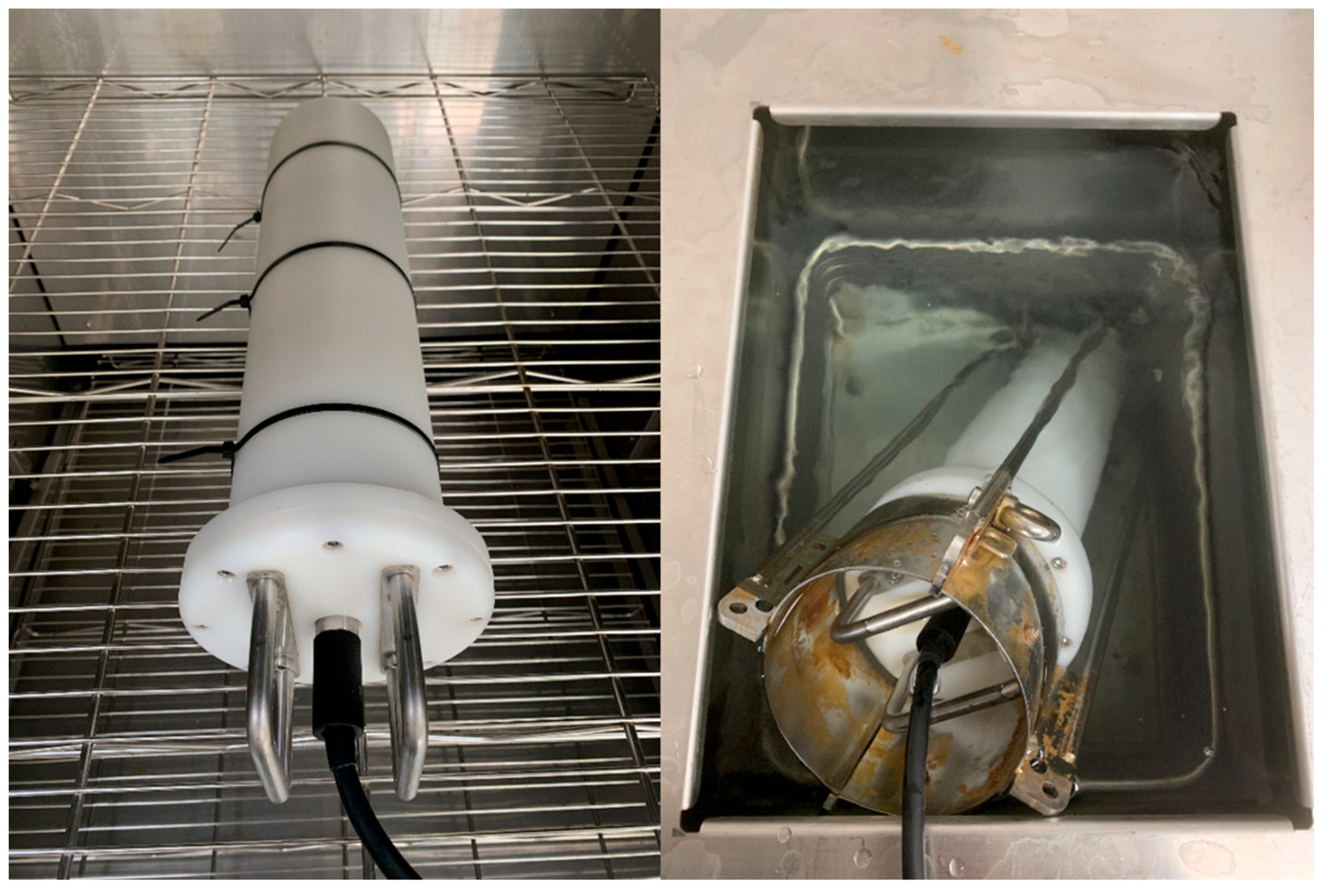

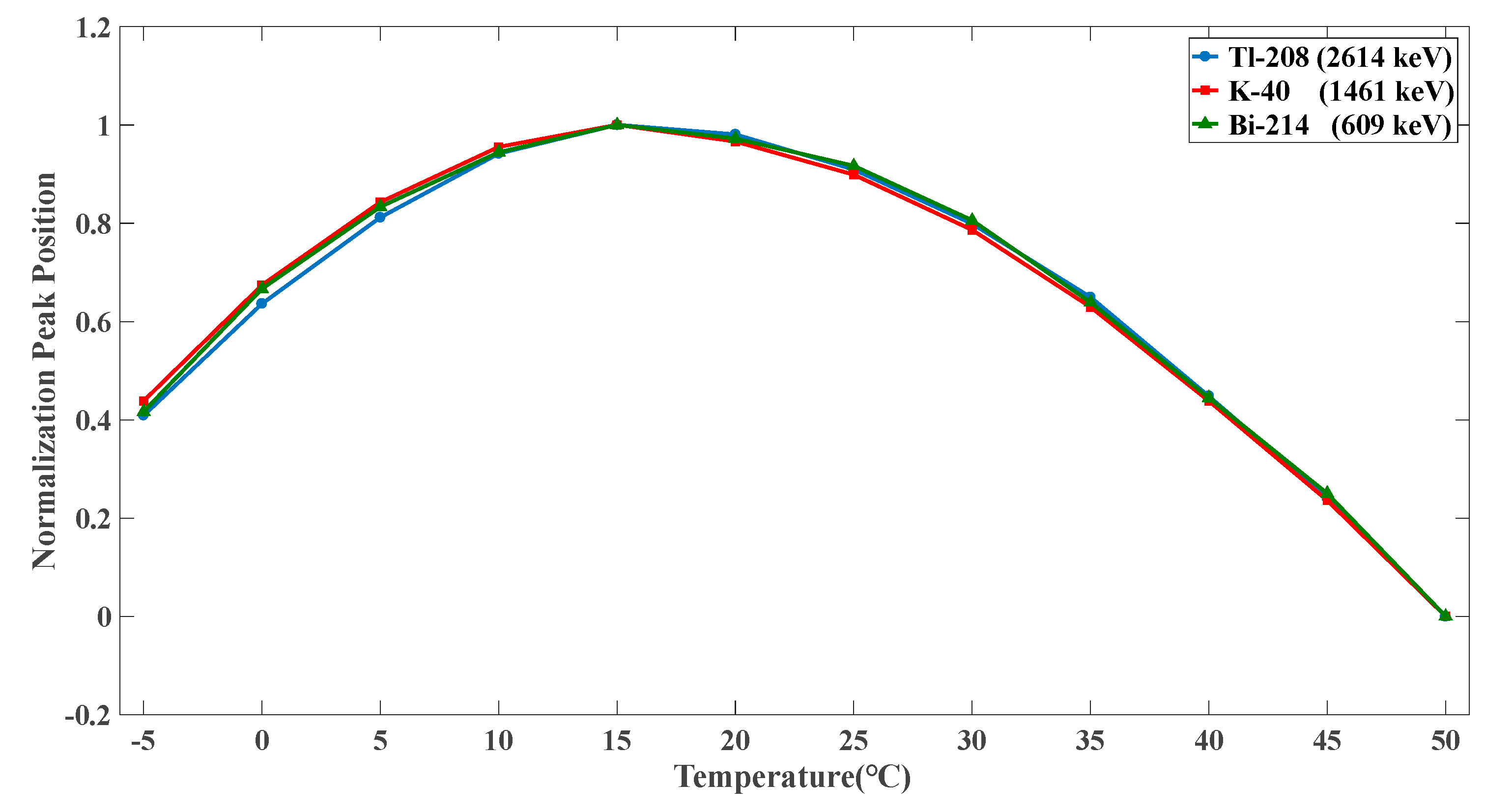
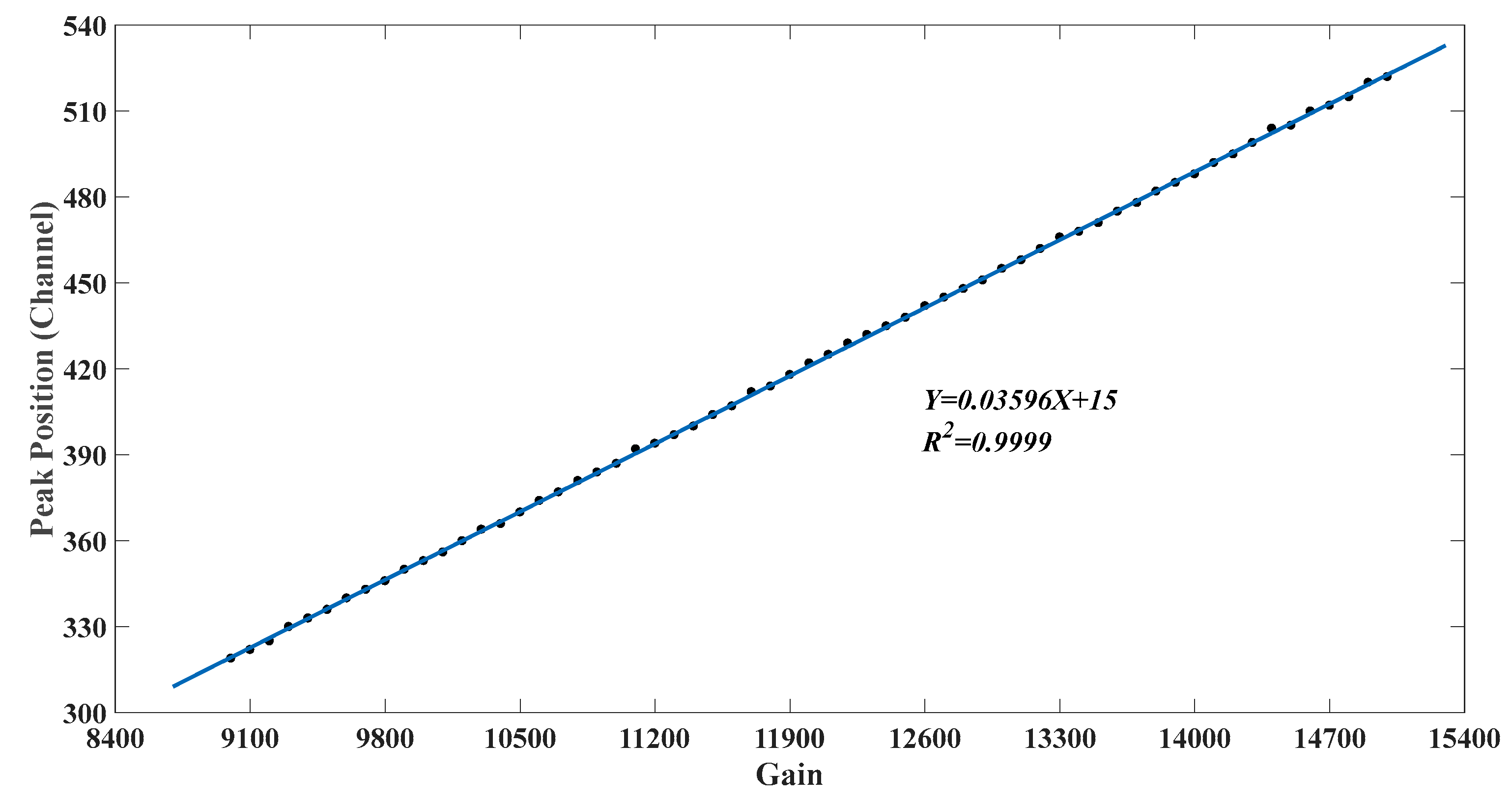
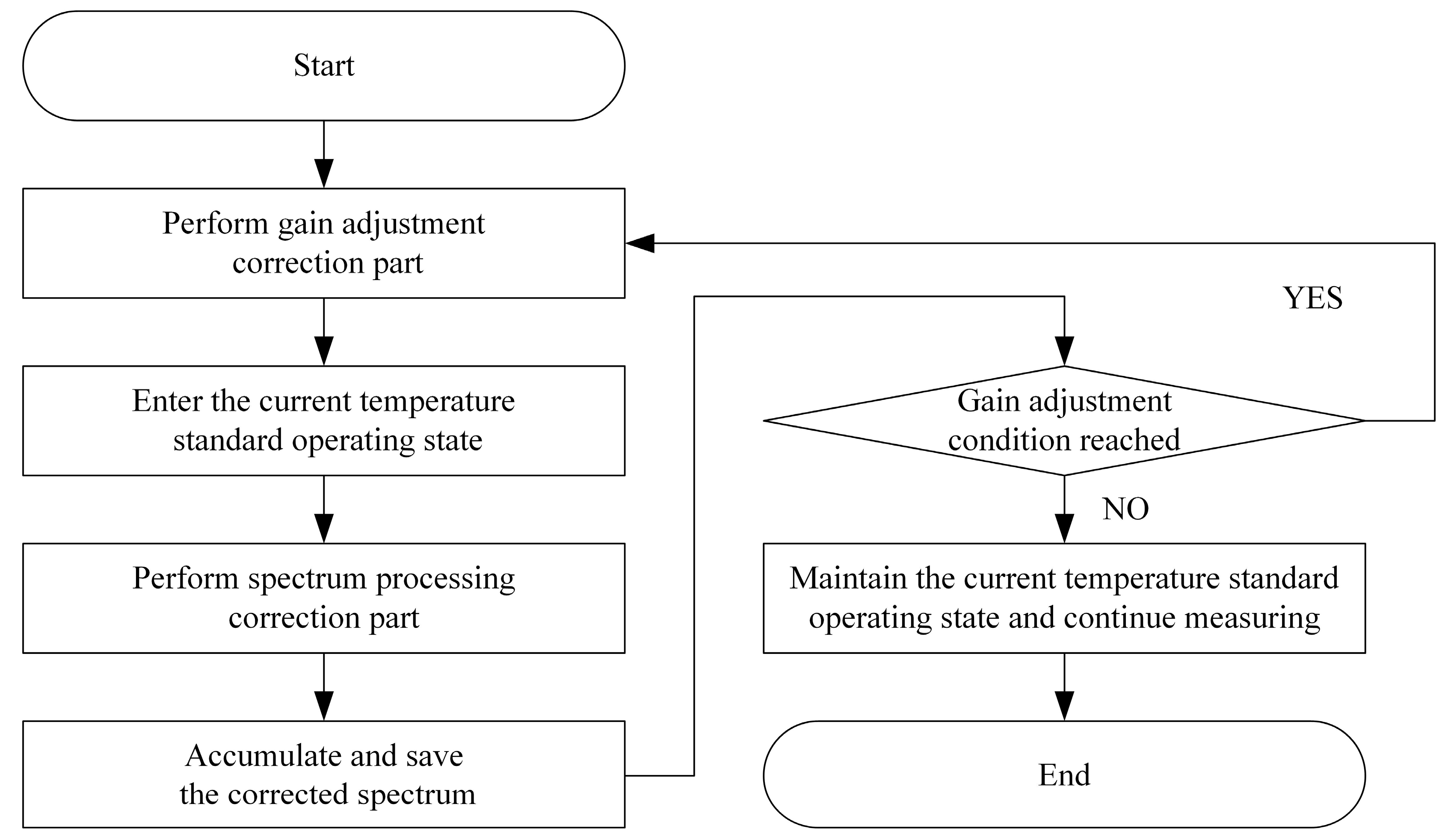
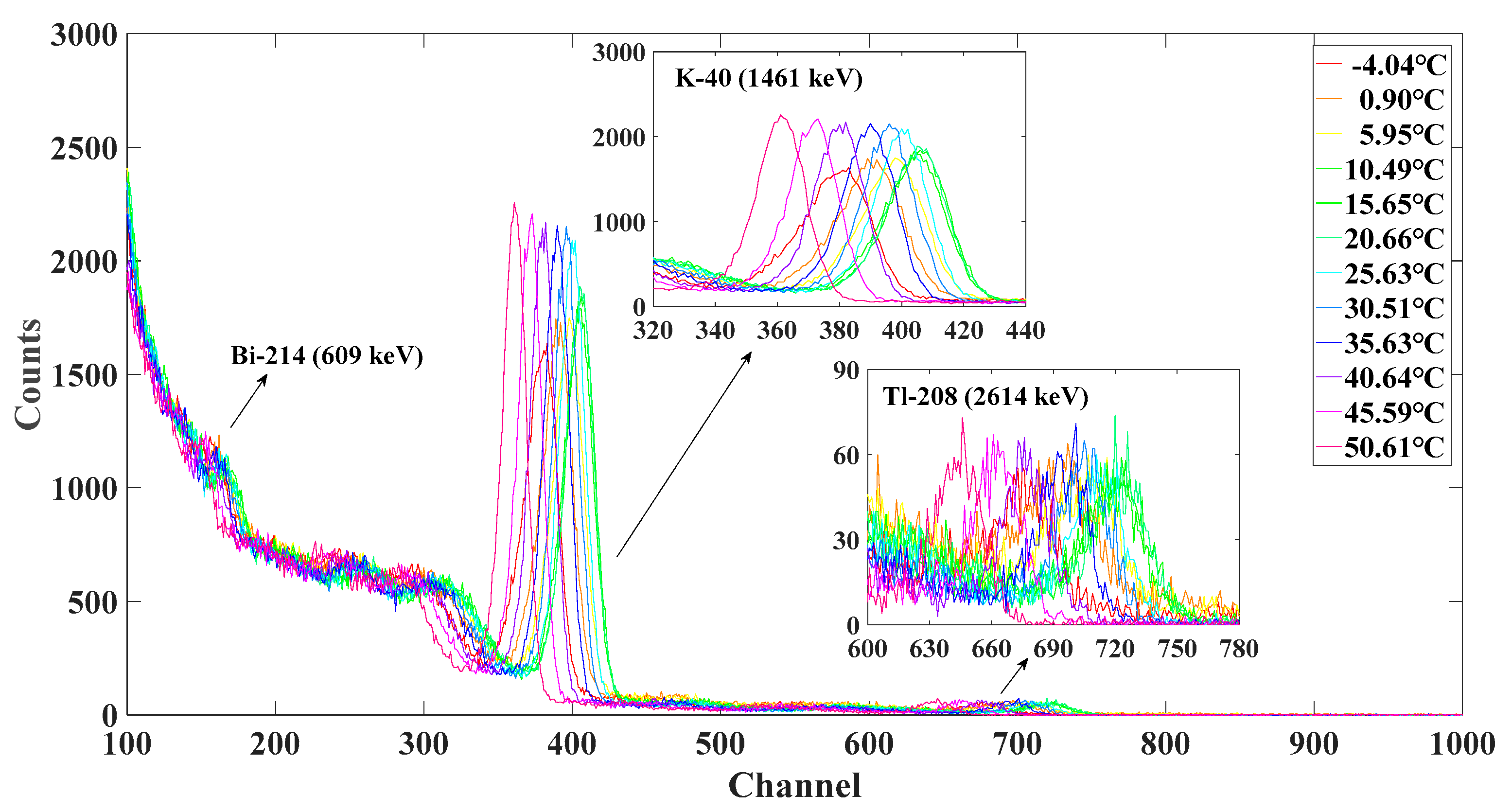
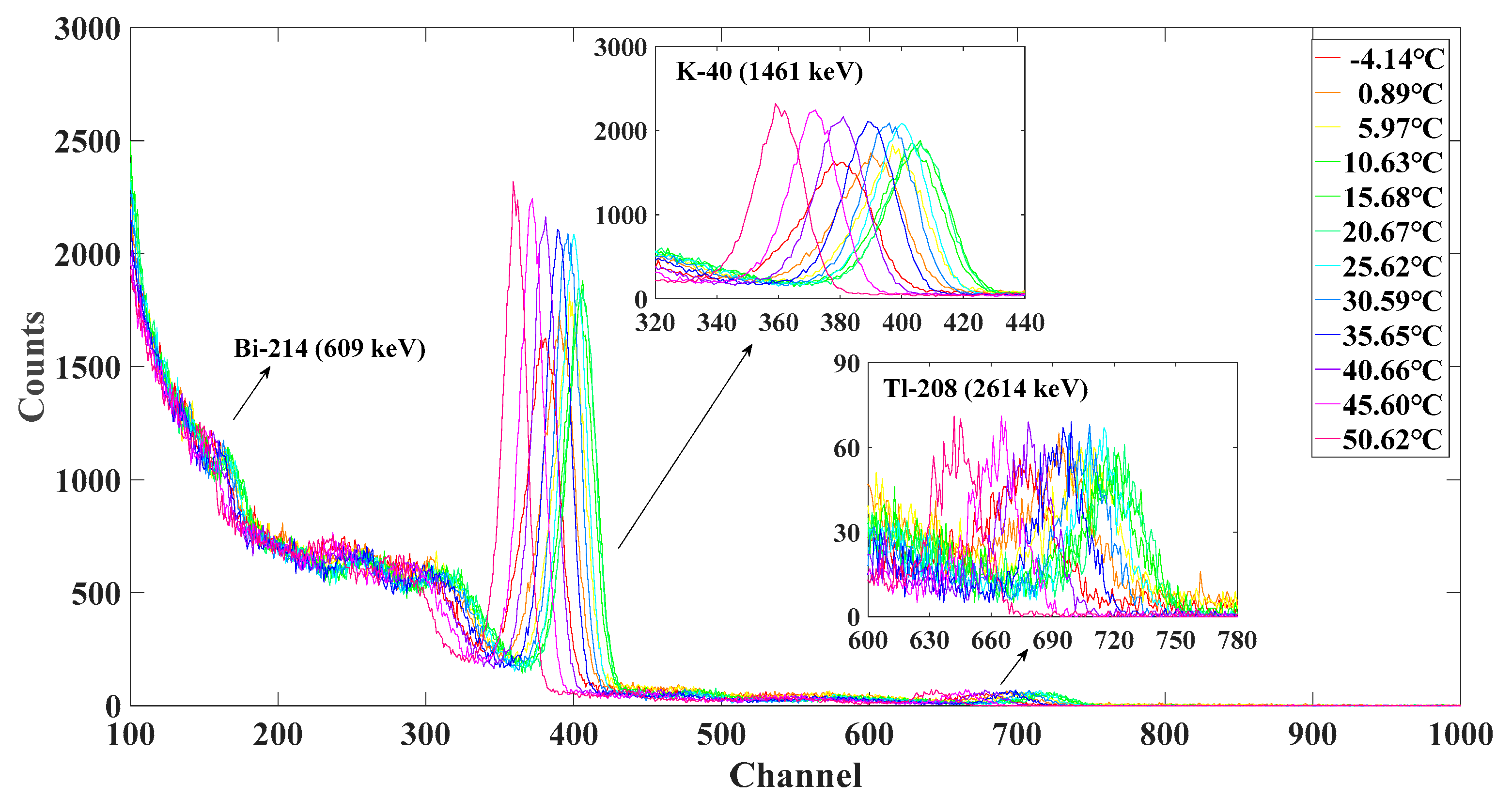
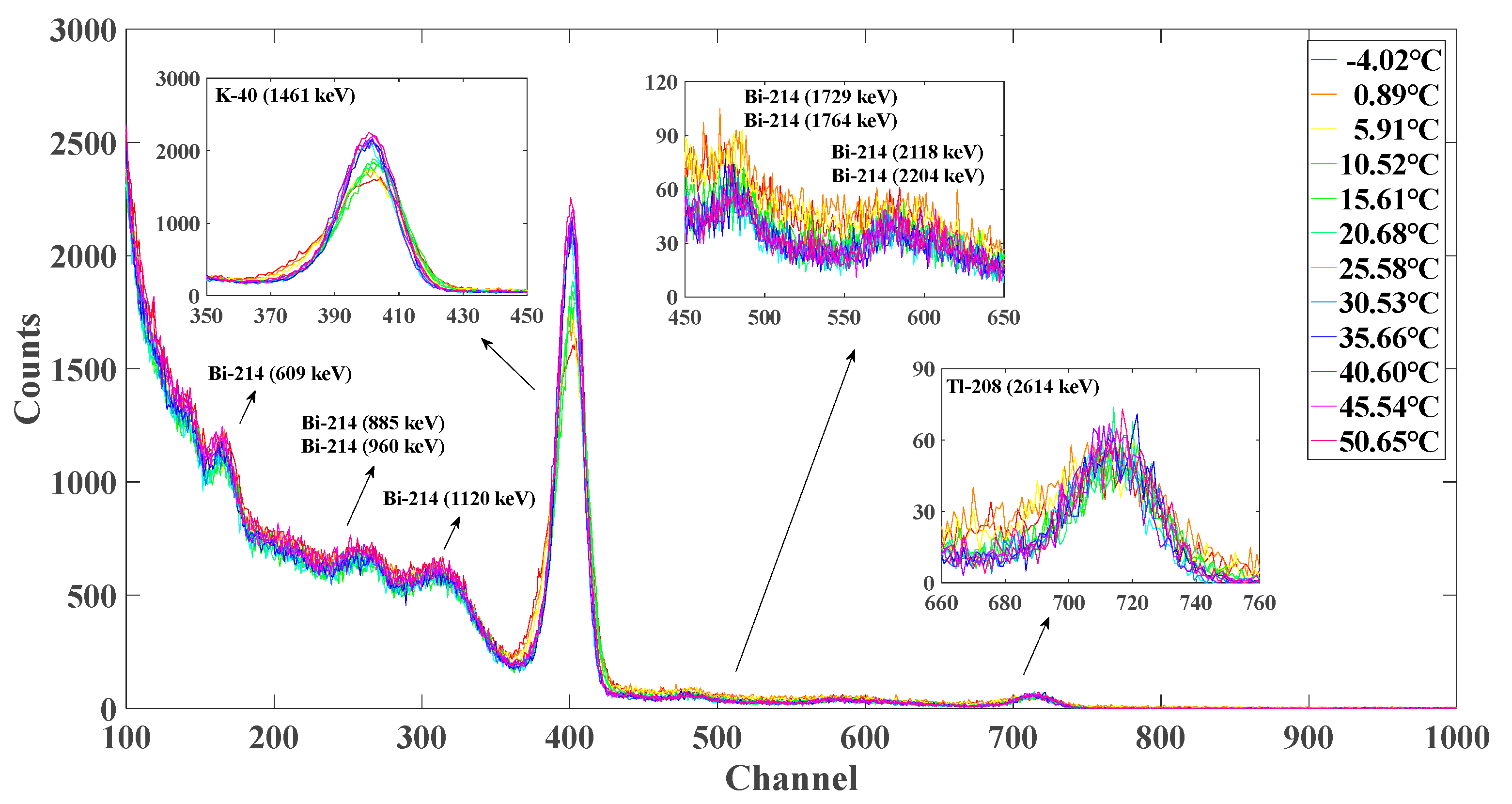

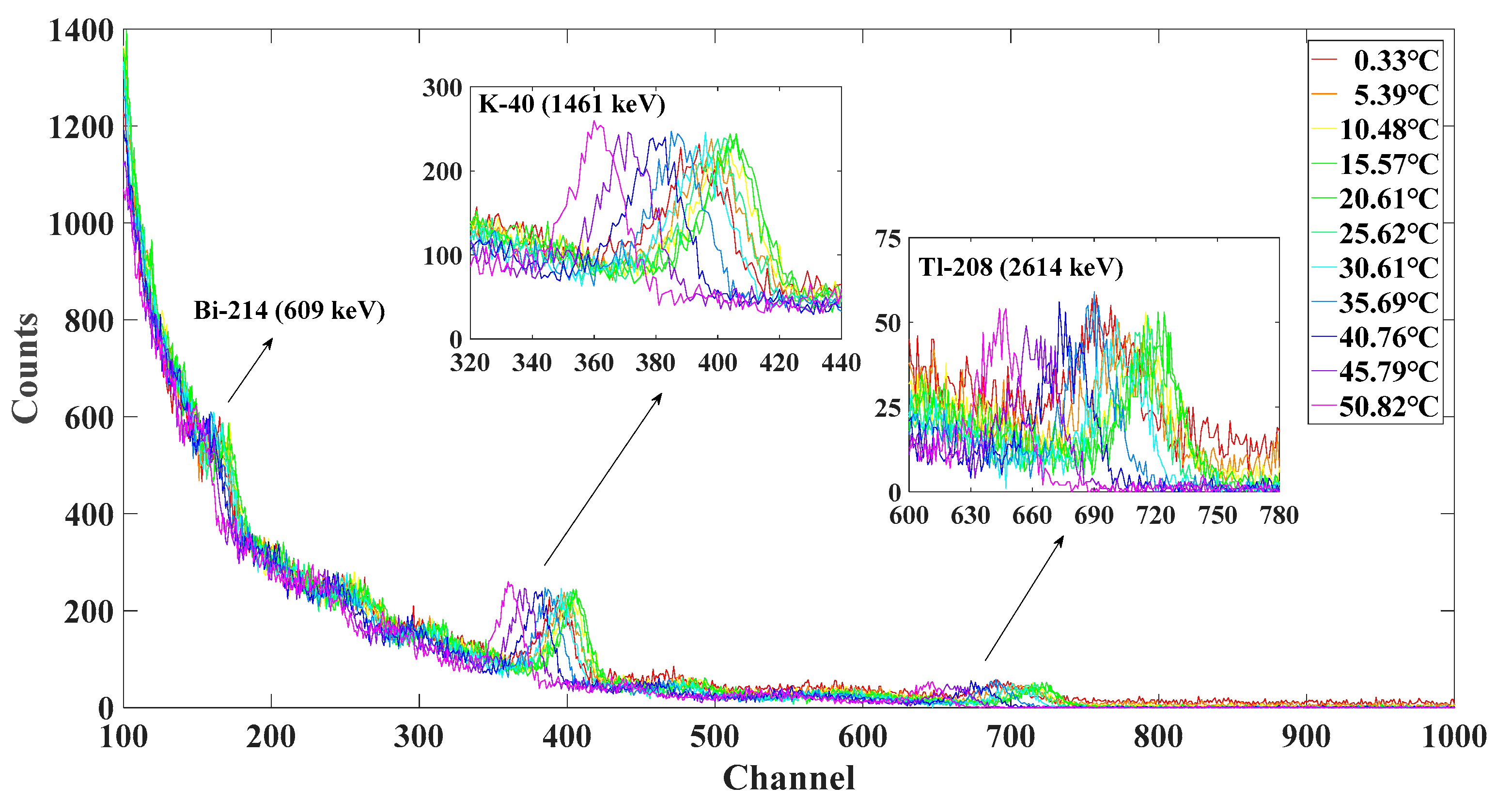
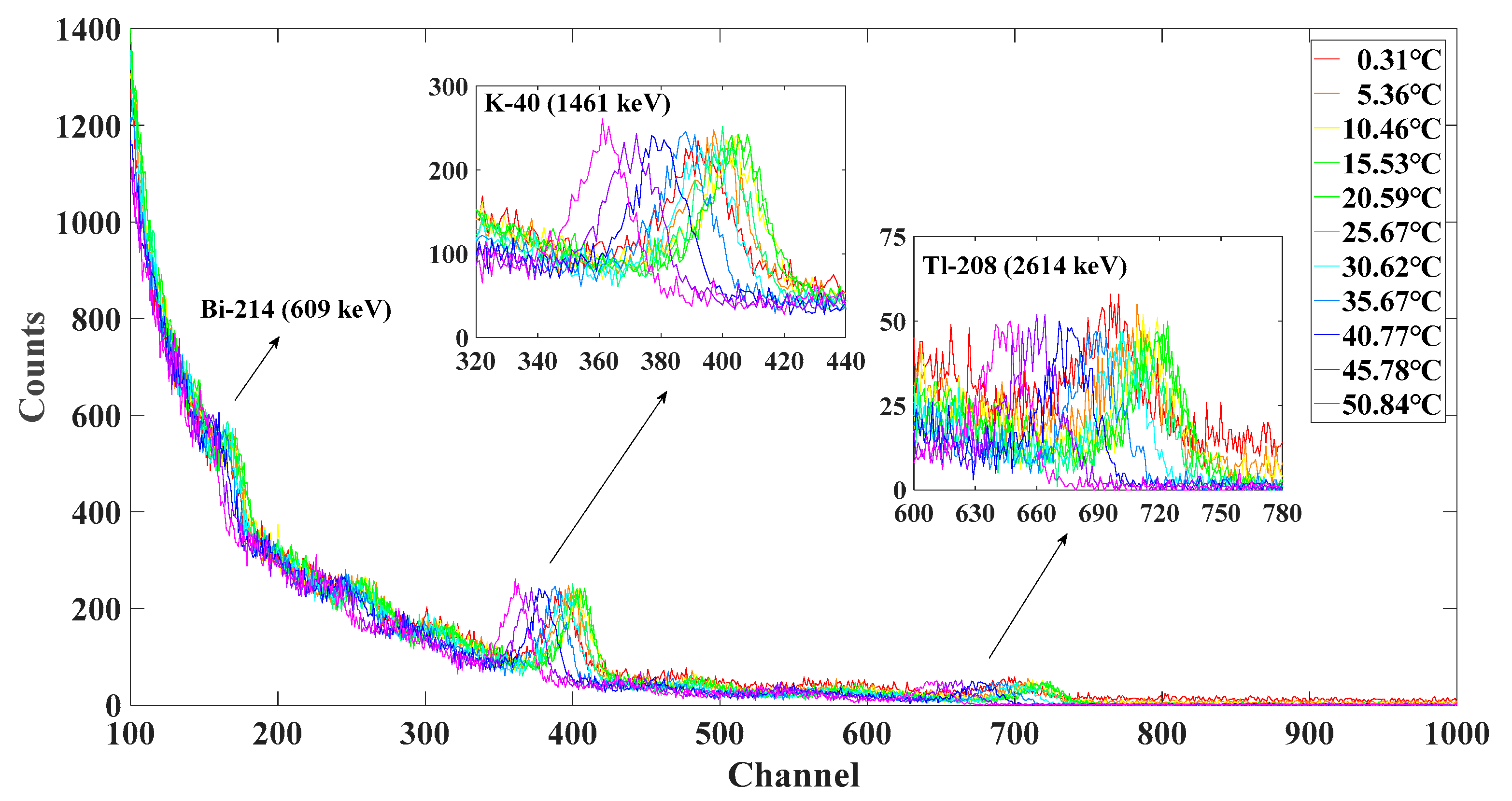
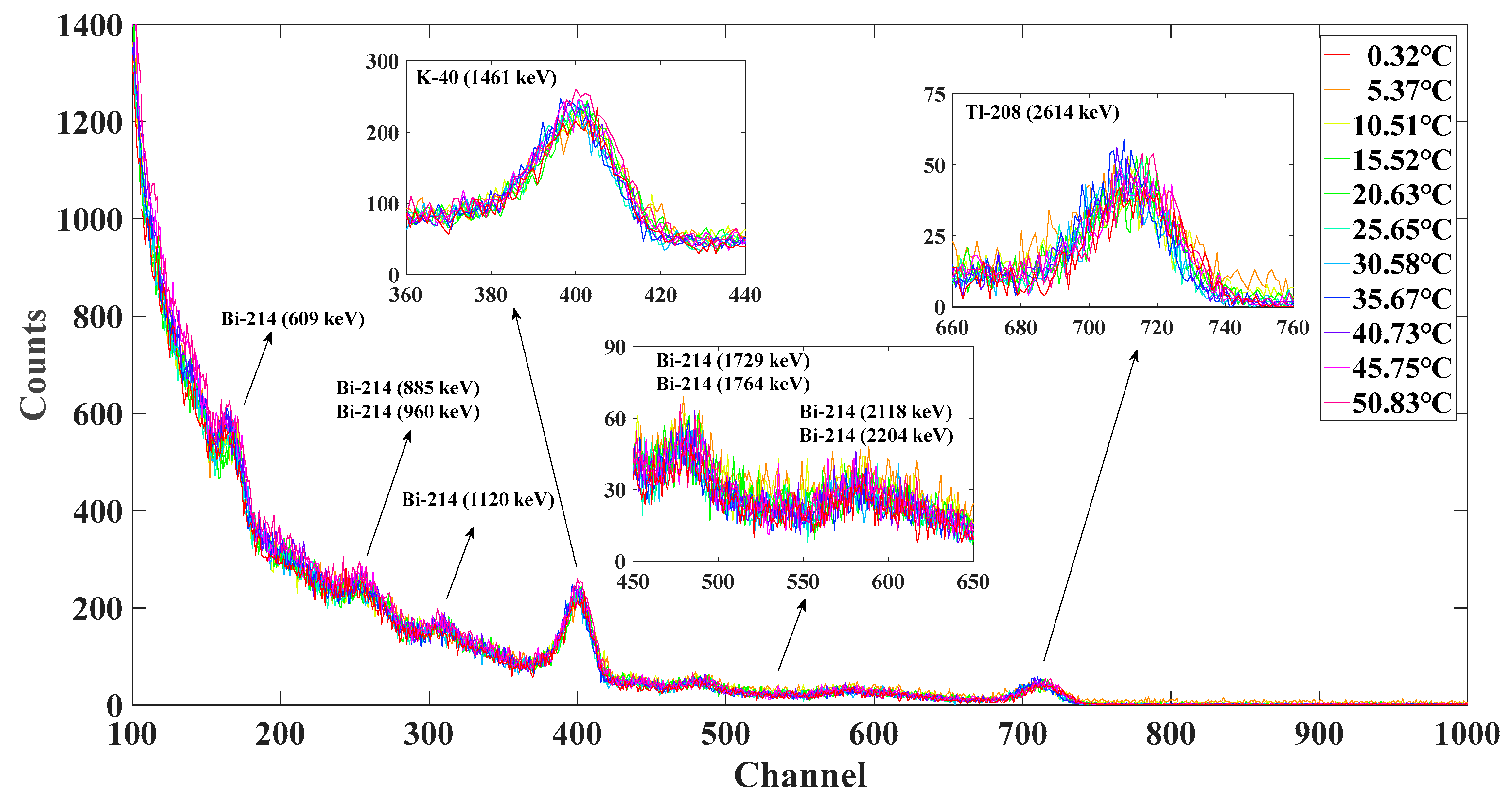

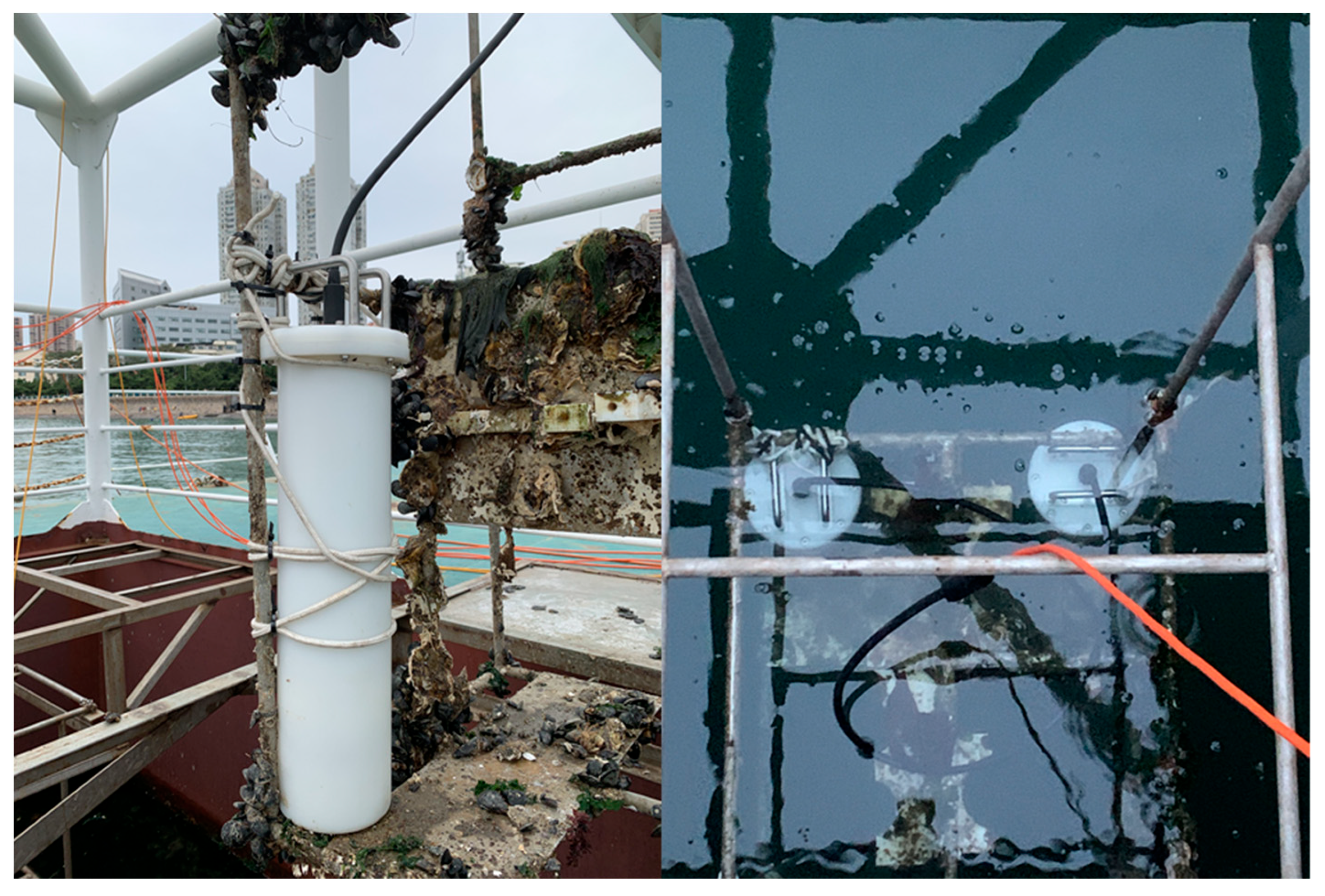
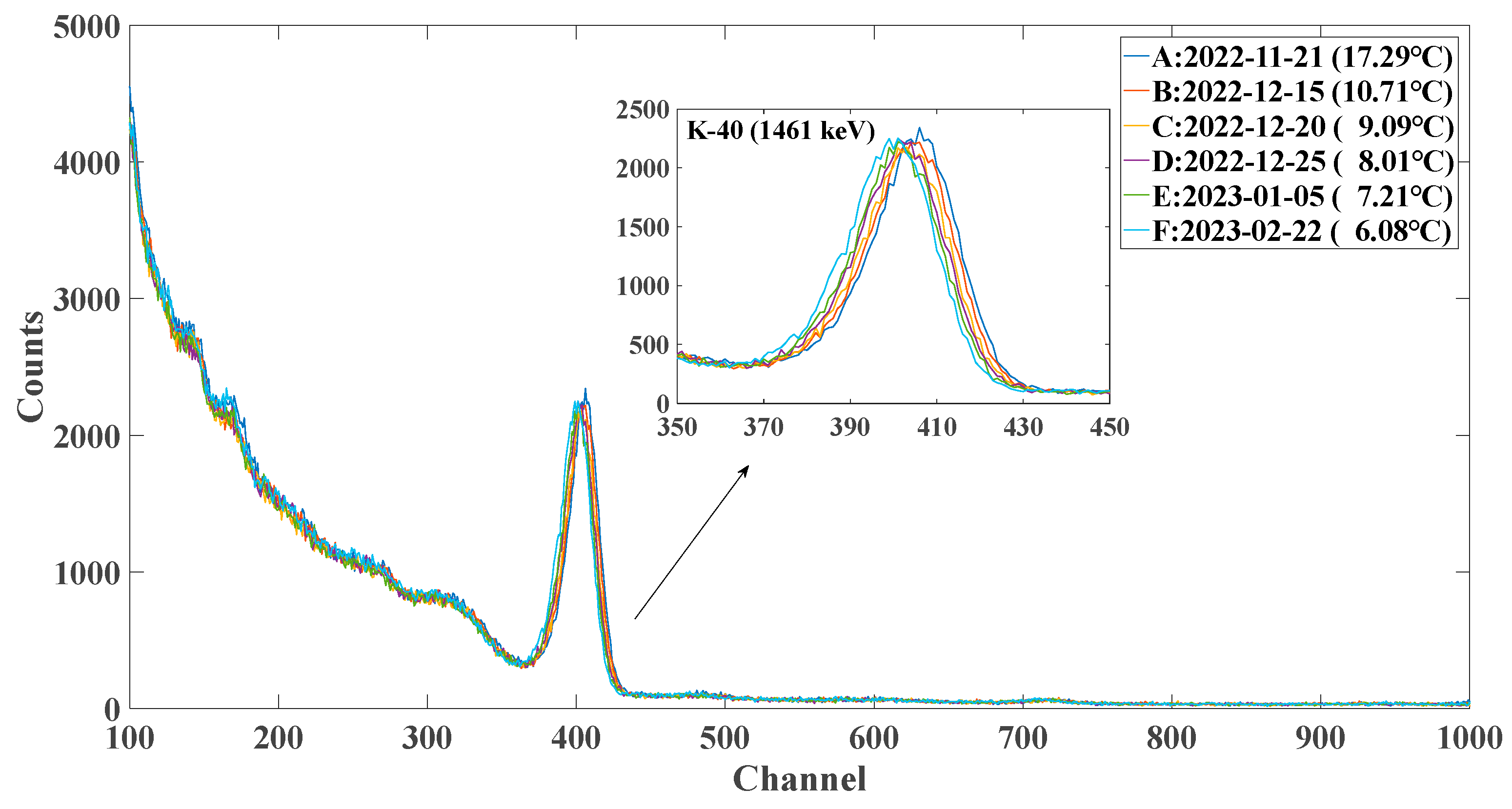
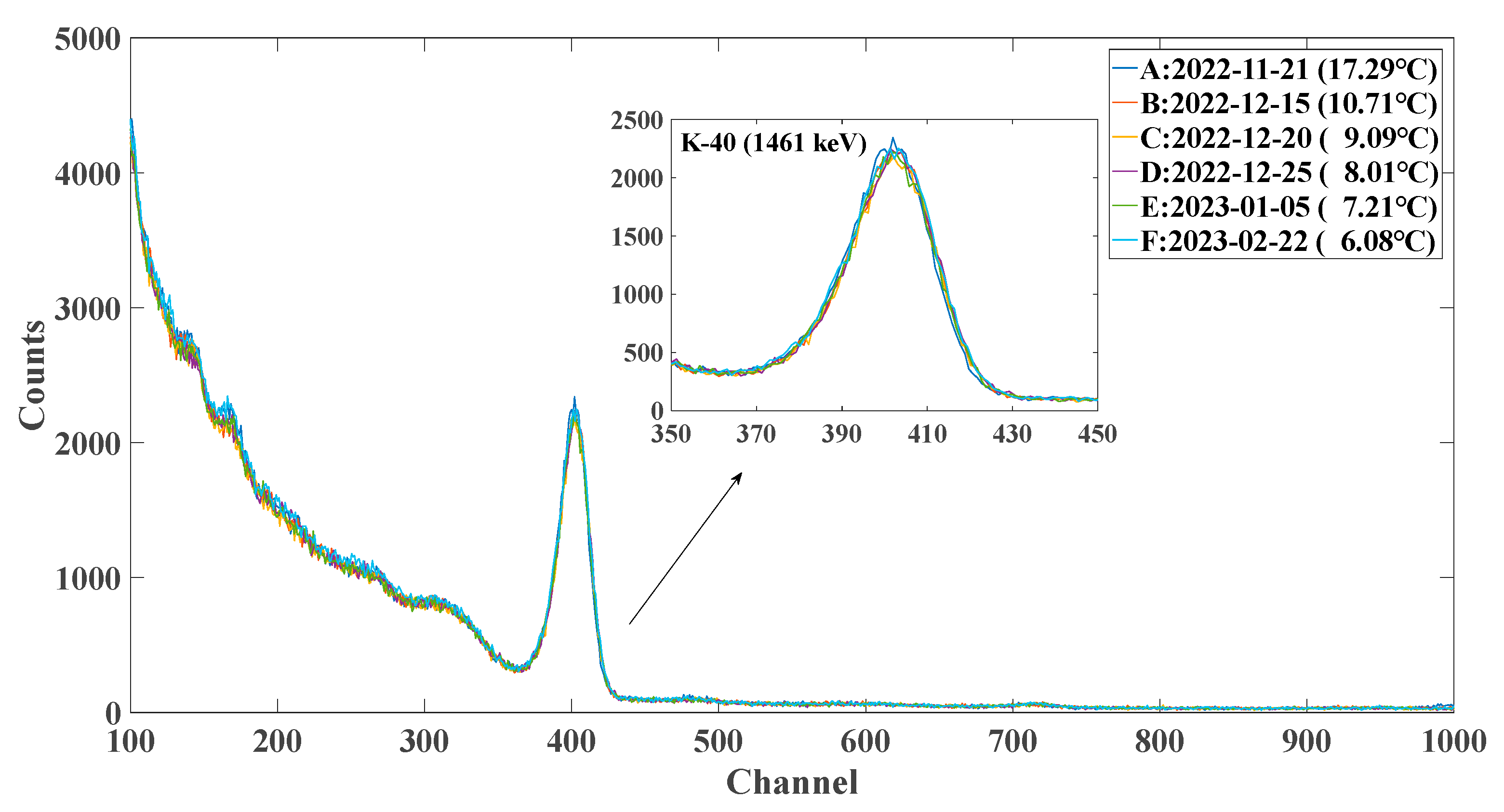
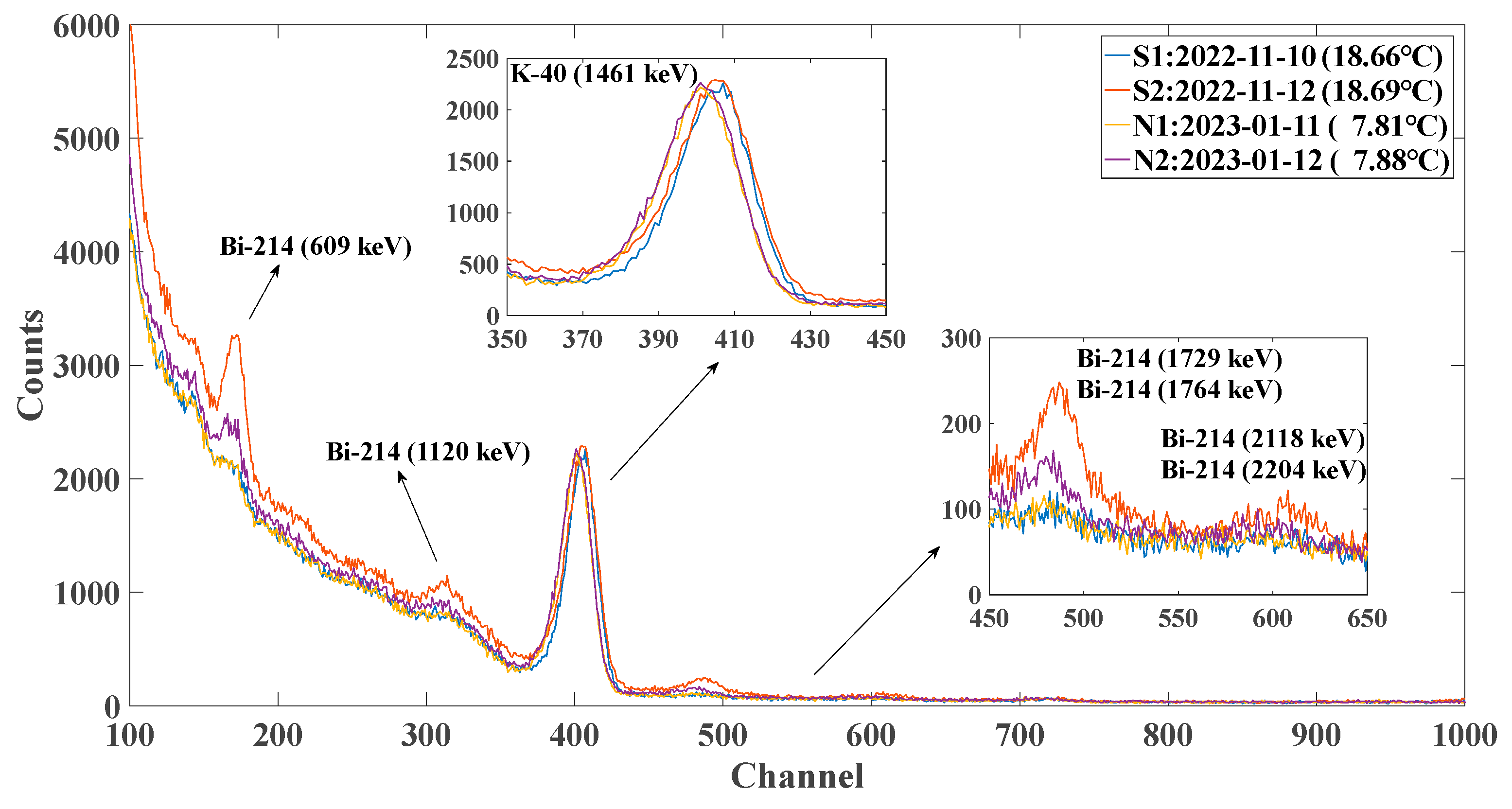

| Parameter | Index |
|---|---|
| Sensor type | 3″ × 3″ NaI(Tl) |
| Energy Range | Adjustable (Max < 3000 keV) |
| Energy Resolution | <7% (661.6 keV) |
| Minimum detectable activity | ~20 Bq m−3 (in 24 h) (661.6 keV) |
| Spectroscopy | 1024 channels |
| Operating temperature | −5~50 °C |
| Operating voltage | 9~18 V DC |
| Consumption | ~2 W |
| Communication protocol | RS485 |
| Temperature Point (°C) | Fitting Relation | R2 | k |
|---|---|---|---|
| −5 | Y = 0.03441X + 13.68 | 0.9999 | 0.03441 |
| 0 | Y = 0.03529X + 14.29 | 0.9999 | 0.03529 |
| 5 | Y = 0.03564X + 15.57 | 0.9999 | 0.03564 |
| 10 | Y = 0.03614X + 14.29 | 0.9999 | 0.03614 |
| 15 | Y = 0.03643X + 14.14 | 0.9999 | 0.03643 |
| 20 | Y = 0.03618X + 16.29 | 0.9999 | 0.03618 |
| 25 | Y = 0.03596X + 15.00 | 0.9999 | 0.03596 |
| 30 | Y = 0.03511X + 20.00 | 0.9999 | 0.03511 |
| 35 | Y = 0.03486X + 14.14 | 0.9999 | 0.03486 |
| 40 | Y = 0.03418X + 14.14 | 0.9999 | 0.03418 |
| 45 | Y = 0.03329X + 13.71 | 0.9999 | 0.03329 |
| 50 | Y = 0.03211X + 16.00 | 0.9999 | 0.03211 |
| Temperature Point (°C) | Cooling Process | Heating Process | ||||||
|---|---|---|---|---|---|---|---|---|
| Before | After | Before | After | |||||
| 40K | 208Tl | 40K | 208Tl | 40K | 208Tl | 40K | 208Tl | |
| −5 | 380 | 675 | 399 | 711 | 379 | 672 | 401 | 711 |
| 0 | 392 | 695 | 400 | 712 | 392 | 695 | 400 | 712 |
| 5 | 396 | 705 | 400 | 712 | 397 | 705 | 400 | 712 |
| 10 | 403 | 717 | 400 | 712 | 403 | 717 | 401 | 712 |
| 15 | 404 | 718 | 400 | 712 | 405 | 718 | 401 | 712 |
| 20 | 403 | 717 | 400 | 712 | 403 | 717 | 401 | 712 |
| 25 | 400 | 712 | 400 | 712 | 399 | 712 | 400 | 712 |
| 30 | 394 | 701 | 400 | 713 | 394 | 701 | 401 | 713 |
| 35 | 388 | 690 | 400 | 713 | 388 | 689 | 400 | 713 |
| 40 | 379 | 676 | 400 | 713 | 379 | 676 | 400 | 713 |
| 45 | 370 | 660 | 400 | 713 | 370 | 660 | 401 | 714 |
| 50 | 359 | 641 | 400 | 713 | 360 | 643 | 401 | 714 |
| Temperature Point (°C) | Cooling Process | Heating Process | ||||||
|---|---|---|---|---|---|---|---|---|
| Before | After | Before | After | |||||
| 40K | 208Tl | 40K | 208Tl | 40K | 208Tl | 40K | 208Tl | |
| 0 | 391 | 694 | 400 | 711 | 391 | 694 | 400 | 711 |
| 5 | 397 | 706 | 400 | 711 | 398 | 706 | 400 | 711 |
| 10 | 402 | 716 | 400 | 712 | 402 | 716 | 400 | 711 |
| 15 | 405 | 719 | 400 | 712 | 405 | 719 | 400 | 712 |
| 20 | 404 | 718 | 400 | 712 | 404 | 718 | 400 | 712 |
| 25 | 400 | 712 | 400 | 712 | 400 | 712 | 400 | 712 |
| 30 | 393 | 700 | 400 | 712 | 393 | 700 | 400 | 712 |
| 35 | 389 | 691 | 400 | 713 | 389 | 690 | 400 | 712 |
| 40 | 379 | 677 | 400 | 713 | 379 | 677 | 400 | 713 |
| 45 | 369 | 659 | 400 | 713 | 369 | 659 | 400 | 713 |
| 50 | 358 | 640 | 400 | 713 | 359 | 641 | 400 | 713 |
Disclaimer/Publisher’s Note: The statements, opinions and data contained in all publications are solely those of the individual author(s) and contributor(s) and not of MDPI and/or the editor(s). MDPI and/or the editor(s) disclaim responsibility for any injury to people or property resulting from any ideas, methods, instructions or products referred to in the content. |
© 2024 by the authors. Licensee MDPI, Basel, Switzerland. This article is an open access article distributed under the terms and conditions of the Creative Commons Attribution (CC BY) license (https://creativecommons.org/licenses/by/4.0/).
Share and Cite
Shi, Y.; Zhang, Y.; Feng, X.; Yuan, D.; Wu, B.; Bi, H. A New Method for the Correction of Spectrum Drift Caused by Temperature Changes When Using a NaI(Tl) Seawater Radioactivity Sensor. J. Mar. Sci. Eng. 2024, 12, 546. https://doi.org/10.3390/jmse12040546
Shi Y, Zhang Y, Feng X, Yuan D, Wu B, Bi H. A New Method for the Correction of Spectrum Drift Caused by Temperature Changes When Using a NaI(Tl) Seawater Radioactivity Sensor. Journal of Marine Science and Engineering. 2024; 12(4):546. https://doi.org/10.3390/jmse12040546
Chicago/Turabian StyleShi, Yan, Yingying Zhang, Xiandong Feng, Da Yuan, Bingwei Wu, and Haijie Bi. 2024. "A New Method for the Correction of Spectrum Drift Caused by Temperature Changes When Using a NaI(Tl) Seawater Radioactivity Sensor" Journal of Marine Science and Engineering 12, no. 4: 546. https://doi.org/10.3390/jmse12040546
APA StyleShi, Y., Zhang, Y., Feng, X., Yuan, D., Wu, B., & Bi, H. (2024). A New Method for the Correction of Spectrum Drift Caused by Temperature Changes When Using a NaI(Tl) Seawater Radioactivity Sensor. Journal of Marine Science and Engineering, 12(4), 546. https://doi.org/10.3390/jmse12040546





